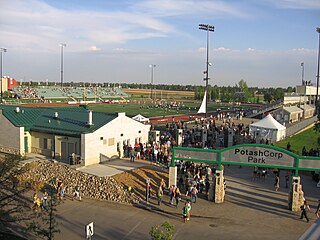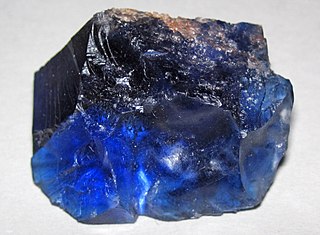Related Research Articles

Potash includes various mined and manufactured salts that contain potassium in water-soluble form. The name derives from pot ash, plant ashes or wood ash soaked in water in a pot, the primary means of manufacturing potash before the Industrial Era. The word potassium is derived from potash.

The University of Saskatchewan is a Canadian public research university, founded on March 19, 1907, and located on the east side of the South Saskatchewan River in Saskatoon, Saskatchewan, Canada. An "Act to establish and incorporate a University for the Province of Saskatchewan" was passed by the provincial legislature in 1907. It established the provincial university on March 19, 1907 "for the purpose of providing facilities for higher education in all its branches and enabling all persons without regard to race, creed or religion to take the fullest advantage". The University of Saskatchewan is the largest education institution in the Canadian province of Saskatchewan. The University of Saskatchewan is one of Canada's top research universities and is a member of the U15 Group of Canadian Research Universities.

Agrium Inc. was a major retail supplier of agricultural products and services in North America, South America and Australia and a wholesale producer and marketer of all three major agricultural nutrients and a supplier of specialty fertilizers in North America.

The Potash Corporation of Saskatchewan, also known as PotashCorp, was a company based in Saskatoon, Saskatchewan. The company merged with Calgary-based Agrium to form Nutrien, in a transaction that closed on January 1, 2018.

Esterhazy is a town in the south-eastern part of the Canadian province of Saskatchewan, 83 kilometres (52 mi) south-east of Yorkton along Highways 22 and 80. The town is in the Rural Municipality of Fertile Belt No. 183.

Griffiths Stadium is a stadium located on the grounds of the University of Saskatchewan in Saskatoon, Saskatchewan. The current stadium was opened on 23 June, 1967, to host the Saskatchewan Huskies football team. There was previously a Griffiths Stadium 200 metres to the east of the current location, which operated from 1936 until the new site was opened.
The Saskatchewan Railway Museum is a railway museum located west of Saskatoon, Saskatchewan at the intersection of the Pike Lake Highway and the Canadian National Railway tracks. It is operated by the Saskatchewan Railroad Historical Association (SRHA) and was opened in 1990.
Highway 316 is a provincial highway in the Canadian province of Saskatchewan. The highway is in the RM of Blucher No. 343 and runs from Highway 16 near Clavet north to Highway 5. It is a primary weight highway and the land around it is an industrial and commercial area. The highway intersects with Highway 394 and the Canadian National and Canadian Pacific Railways. It is about 17 kilometres (11 mi) long.
Moosomin is a town in southern Saskatchewan founded in 1882. It is 20 kilometres west of the provincial boundary between Saskatchewan and Manitoba.

Vanscoy is a village in the Canadian province of Saskatchewan within the Rural Municipality of Vanscoy No. 345 and Census Division No. 12. Vanscoy is located on Highway 7 near Highway 762 in central Saskatchewan, 29 km southwest of the City of Saskatoon. Rice Lake is to the west, Goose Lake is to the north, and Pike Lake and Pike Lake Provincial Park are to the east. One of the largest economic industries near Vanscoy is Agrium Vanscoy Potash Operations which produces 1,790,000 metric tonnes of potash a year. Community facilities include a circle hall, ice rink, curling rink and ball diamond.

Colonsay is a town in the Rural Municipality of Colonsay No. 342, in the Canadian province of Saskatchewan. Colonsay is located on Highway 16 running east–west in central Saskatchewan near the intersection with Highway 2.

Rocanville is a town in Saskatchewan, Canada, and home to the largest oil can in the world. It is home of the Nutrien Rocanville mine. Rocanville is also home of the Symons Oiler factory which produced over 1 million oil cans during the Second World War. The town erected the giant oil can to commemorate the factory.

John Stratford Burton was a Canadian politician who represented the electoral district of Regina East in the House of Commons of Canada, from 1968 to 1972. He was a member of the Cooperative Commonwealth Federation and its successor, the New Democratic Party.
There are numerous heritages and cultural attractions in the Canadian province of Saskatchewan. Museums, dinosaur digs, aboriginal cultural and heritage sites, art galleries, professional sport venues, spas, handcraft, antique and tea shops, agricultural tours, theatre, and archaeological sites comprise over 600 varied Saskatchewan institutions.
William "Bill" Doyle was the CEO of the Potash Corporation of Saskatchewan (PotashCorp), the world's largest fertilizer company by capacity. Doyle was CEO of PotashCorp since 1999. On April 6, 2014, Doyle announced his intention to retire on July 1, 2015, and to transition from president and CEO to senior advisor on July 1, 2014, when he was succeeded by Jochen Tilk.
The economy of Saskatchewan has been associated with agriculture resulting in the moniker "Bread Basket of Canada" and Bread Basket of the World. According to the Government of Saskatchewan, approximately 95% of all items produced in Saskatchewan, depend on the basic resources available within the province. Various grains, livestock, oil and gas, potash, uranium, wood and their spin off industries fuel the economy.
Canpotex, short for Canadian Potash Exporters, is a Canadian potash exporting and marketing firm, incorporated in 1970 and operating since 1972. Based in Saskatchewan, Canpotex manages the entire Saskatchewan potash exporting industry, including transportation and delivery.
The Economy of Saskatoon is quite diverse. The city hosts the head-offices for several companies. Various grains, livestock, oil and gas, potash, uranium, wood and their spin off industries fuel the economy. The world's largest publicly traded uranium company, Cameco, and the world's largest potash producer, Nutrien, have corporate headquarters in Saskatoon. Nearly two-thirds of the world's recoverable potash reserves are located in the Saskatoon region.
Ultra Colonsay is a Panamax bulk cargo carrier owned by Toei Japan. It was built as U-Sea Colonsay for Canpotex of Canada to transport potash between Canada and destinations in Asia. The ship made its maiden voyage in October 2011 from Japan to Vancouver; it is named after the Colonsay Potash Mine in Province of Saskatchewan, where some of the potash it carried originates. This ship is one of nine vessels to be built for a joint venture operated by U-SEA and Canpotex. The vessel was built by Shin Kasado Dockyard.

The Prairie Evaporite Formation, also known as the Prairie Formation, is a geologic formation of Middle Devonian (Givetian) age that consists primarily of halite and other evaporite minerals. It is present beneath the plains of northern and eastern Alberta, southern Saskatchewan and southwestern Manitoba in Canada, and it extends into northwestern North Dakota and northeastern Montana in the United States.
References
- ↑ Press Release
- ↑ Arrives in Vancouver for Maiden voyage Archived 2011-10-09 at the Wayback Machine